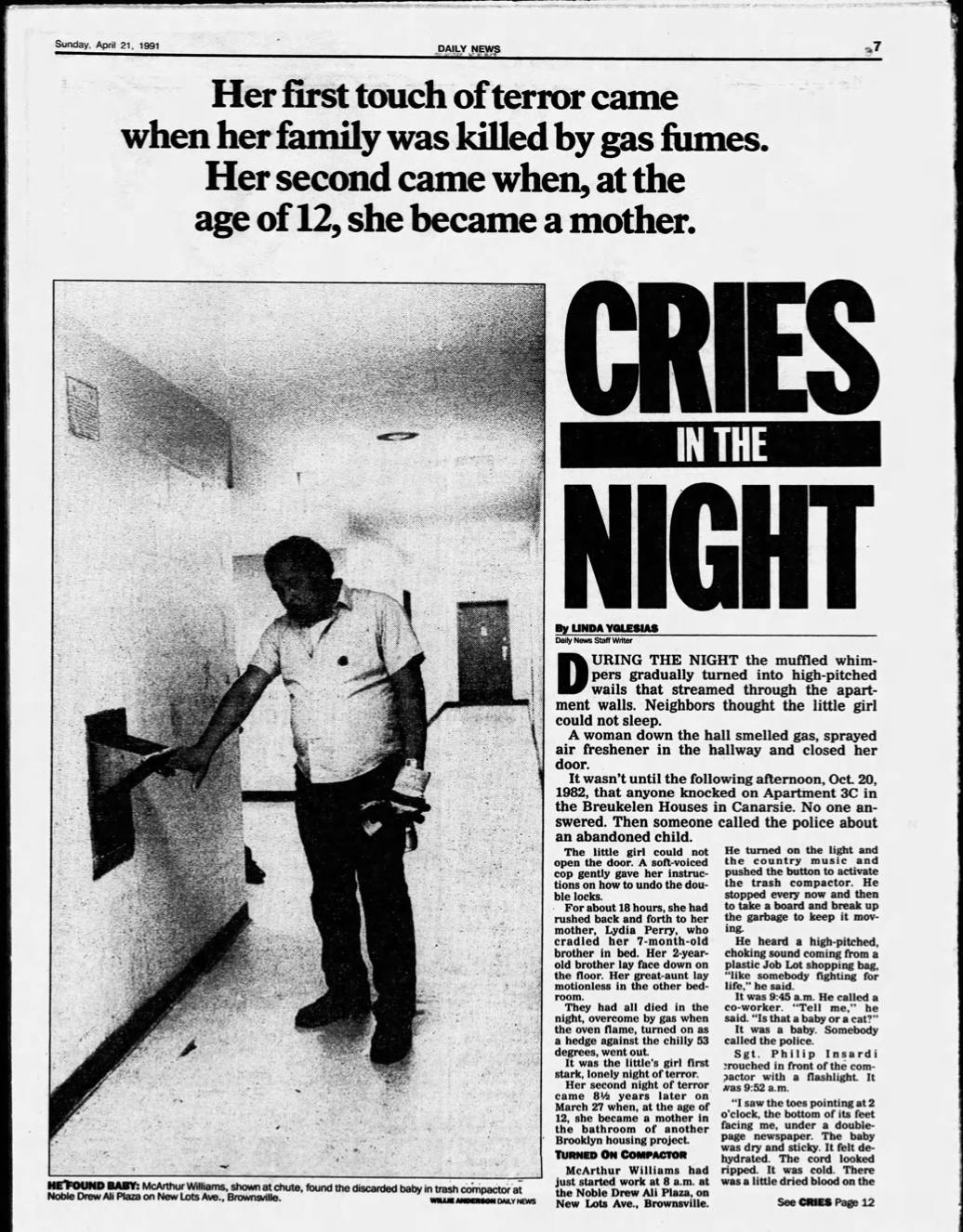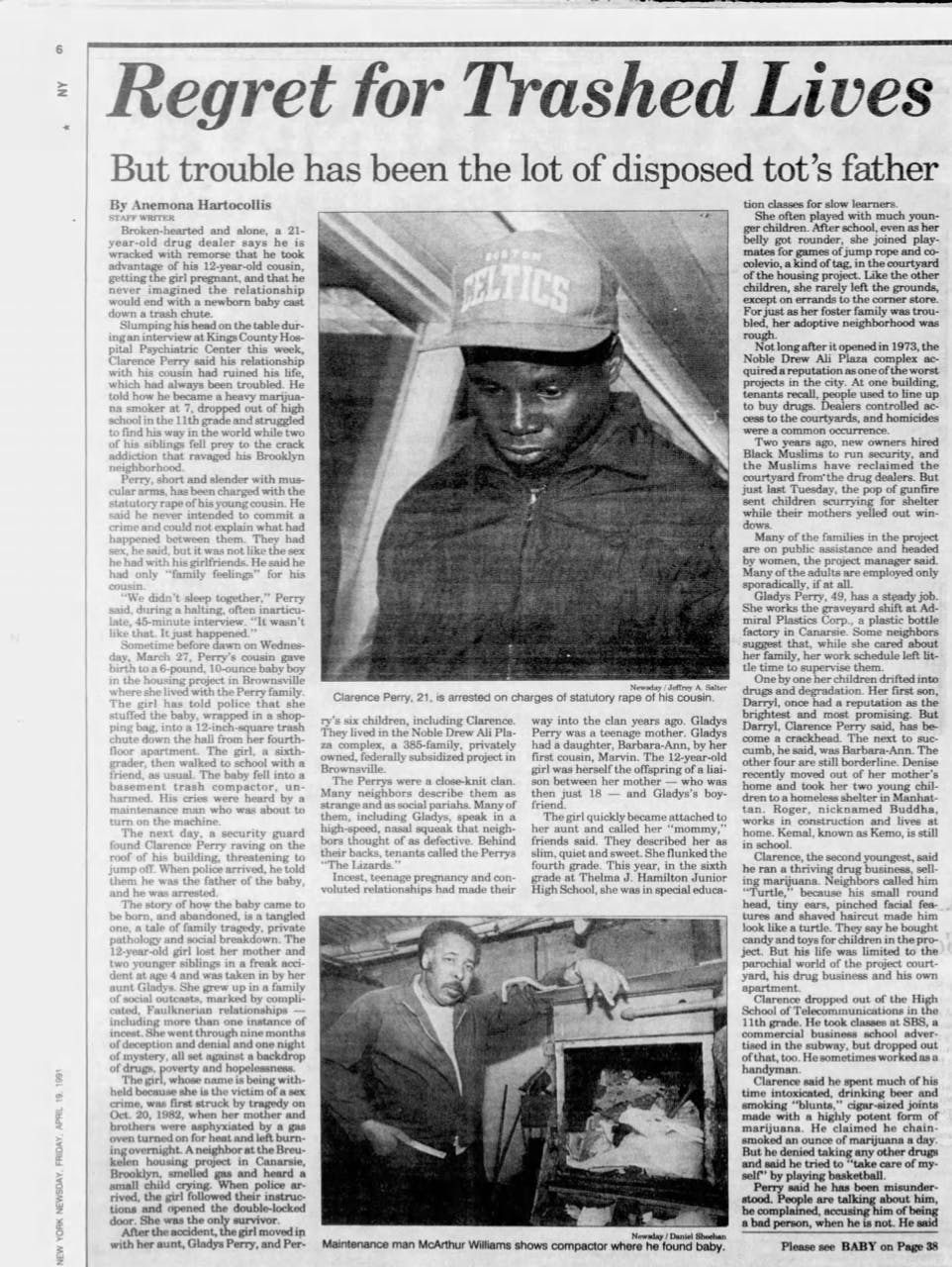
In 1990, nearly 400 girls younger than 15 had children in New York City. Another 675 had abortions. But one pregnancy, in particular, garnered national headlines. On March 27, 1991, a 12 year old gave birth to a baby boy in the Noble Drew Ali Plaza, a 385-family, privately owned, federally subsidized project in Brownsville
Editor's note: We've chosen to redact the victim's name in this story.
After coming into the world, the 6-pound, 10-ounce baby was wrapped in a shopping bag and fed through a 12-inch-square trash chute. The mother then proceeded to go to her 6th grade special education classes at Thelma J. Hamilton Junior High School on Rockaway Avenue. School hadn't come easy for her; she had flunked the 4th grade, and preferred to play jump rope and cocolevio (a form of tag) with younger children because they were more intellectually on par with her.
Maintenance man, McArthur Williams, had just started work at 8 a.m. He flipped on the lights, activated the gnawing sound of the trash compactor, and put on some country music to drown out the sound of metal eating through cardboard. At 9:45 a.m., he heard a high-pitched, choking sound emanating from a Job Lot shopping bag.
"Is that a baby or a cat?" he asked himself.
Williams called two other workers to confirm his suspicion that something was inside the trash compactor. Thoroughly convinced, they called 911.
Sergeant Philip Insardi responded to the call. He peered inside the trash compactor with a flashlight and saw tiny toes pointing at 2 o'clock underneath a folded newspaper. The infant still had its severed umbilical chord attached, leaves in his eyes, and was caked in dried blood.
Eerily motionless, Insardi was positive that the baby was dead. But when he touched his ice-cold stomach, he curled his legs into the fetal position.
Insardi wrapped the baby in his coat and cradled it en route to Brookdale Hospital where doctors estimated that the baby was born while the mother was standing around 3 a.m in the complex. Based on the condition of the infant, they believe that at dawn, she made up her mind to get rid of her son.
Despite the baby boy's tumultuous beginnings, nurses were relieved to discover that his most pressing medical issue was hypothermia. As they attempted to raise his body temperature and give him formula, baby boy was now referred to as "Trevor."

The 12-year-old mother had endured more in 12 years than many faced in their lifetime. Nearly nine years earlier, on October 20, 1982, gas began filling her families third-floor apartment at 657 W. 108th Street in the Breuklen Houses in Canarsie.
Despite seasonably warm autumnal temperatures during the day, the temperature dipped into the low 50s outside. As a result, the family of five, Anne Stevens (67), Lydia Perry (22), [Redacted] (4) Willie (2), and Frederick (10 months), resorted to using the oven for heat. The temperature was set to 500 degrees, and the oven door was left open, while the newly-installed windows in the unit all remained closed.
The day before, the city council passed a bill that would prosecute landlords who failed to provide heat and hot water to tenants. At the time, the Public Health Code required apartments to be at least 68 degrees between 6 a.m. to 10 p.m., and at 55 degrees between 10 p.m. and 6 a.m. If the outside temperature dropped below 40 degrees at any time between 10 p.m. and 6 a.m., the landlord was required to provide heat.
At 9 p.m., Paulyne Mooney, a neighbor, said that she smelled gas while she was putting out the trash. She sprayed the hall with air freshener, and went back into her apartment. Another neighbor, Victoria Jones, also smelled gas and decided to call police after she also heard [Redacted] crying. She assumed the 4-year-old girl was having a nightmare.
When police arrived, their knocks went unanswered. From behind the door they could make out a little girl's voice saying that she didn't know how to undo the locks. After instructing her how to release the two deadbolts, police entered apartment 3C.
The bodies of Anne Stevens, Lydia Perry, Willie, and Frederick were discovered at 4 p.m. Stevens was in her bed, Lydia and Frederick were in another, and Willie was on the floor. They had died as a result of asphyxiation by inhaling carbon monoxide from the oven after the pilot went out, and all four had more than 60 percent of carbon monoxide present in their blood. [Redacted] was taken to Kings County Hospital and listed in fair condition. Authorities believed she was the lone survivor because she was in a section of the apartment that contained an air pocket.
DROP YOUR EMAIL
TO STAY IN THE KNOW
After her mother, brothers, and great-aunt were buried, [Redacted] went to live with another great-aunt, Gladys Perry, who enjoyed drinking beer at the park with other women while they gossiped about the goings on in the neighborhood. Gladys had her daughter, Barbara-Ann, with her first cousin, Marvin, which made her something of a social pariah amongst her peers. Her other kids, Clarence (Turtle), Roger (Buddha), Kemal (Kemo), and Denise were from different relationships.
By their teens, Barbara-Ann and Clarence had both succumbed to drug addictions. He, at one time, had been a burgeoning basketball star at High School of Telecommunications before dropping out in the 11th grade and turning to selling marijuana. He wasn't a great drug-dealer: he started smoking weed at seven, and now had an ounce a day weed habit that kept him sluggish and unmotivated. He mostly hung round his mother's apartment watching cartoons while the younger kids went to school.
At around 7:40 a.m. on March 27, a neighbor inside the Noble Drew Ali complex, Heidi Dolores Champagne, went to the Perry home to pick up her boyfriend, Curtis, who sometimes fell asleep there. [Redacted], now 12, answered.
"She looked fine to me," Champagne told the N'Y Daily News.'

She was wearing jeans and ironing her other school clothes in Gladys Perry's bedroom. Naturally thin, she had recently picked up a habit of wearing a large coat — even in class. While some girls her age had developed curvaceous figures, most agreed that [Redacted] was still very child-like.
Another neighbor, Darlene, also came over. She and [Redacted] always walked to school together (Darlene was 8). They left at 8 a.m., with Marlene stopping at Public School 41, and [Redacted] heading on to Thelma J. Hamilton.
When the baby was found, building manager, Victor Zilbar, believed the infant could have belonged to one of two families in the complex. The Perry's — known for their nasally voices and a rumor of incest in the family — were his prime target.
When he approached Gladys Perry, she denied that her niece had given birth. But after inspecting the bathroom, she couldn't deny the scent of blood. She thought about how only a week prior, [Redacted] had been playing with a neighbor's kids, and commented that she could be a mother one day. She chalked it up to childhood whimsy. Now, she had to consider if her niece had secretly been pregnant and given birth while she was working the graveyard shift as a plastic-bottle packer at Admiral Plastics Corp. in Canarsie.
Police visited [Redacted] at school. While she initially denied giving birth, she later admitted that the baby was hers. It would be left up to a Family Court judge's discretion whether she could be released to relatives pending trial, placed in foster care or group home, or be sent to Spofford Juvenile Center in the Bronx.
At 8:10 a.m. the following morning, a passerby flagged down Sergeant Timothy Farrell and pointed to a man sitting on the roof of the six-story Noble Drew Ali complex. It was an agitated Clarence Perry, who was now threatening to jump.
"I have a problem with the baby!" he yelled out.
When police arrived, he admitted that he was the father of the baby, and was taken to Brookdale Hospital where he was put under suicide watch. Those in Clarence Perry's orbit — the ones who knew all of the dark family secrets — said he didn't know any better. In the Perry household, there was no line between family love, and romantic love.
Perry was indicted on second degree rape and sexual abuse charges. The 12-year-old girl wasn't indicted in exchange for her cooperation against her cousin.
The case drew national attention, but the fictionalized version of what happened — as chronicled on 2Pac's "Brenda's Got a Baby" from 2Pacalypse Now — ultimately served as the visceral reminder of the true story.
Tupac Shakur was filming the 1992 film, Juice, when he read about it in the newspaper. During a lunch break, he invited fellow co-star, Omar Epps, into his trailer.
“He starts rapping this song to me,” Epps recalled.
"She didn't know what to throw away and what to keep. She wrapped the baby up and threw him in a trash heap." - 2Pac "Brenda's Got a Baby"
Clarence Perry pled guilty to secondary statutory rape, and was given six months in prison and five years probation. Prosecutors said they agreed to a plea deal in order to spare the victim from having to testify.
In August 1991, a similar story emerged in Brooklyn. 19-year-old, Melodie Cummings, gave birth in a stairwell in a Coney Island housing project and then dropped the infant down a trash chute into a compactor 10 stories below.
Between 1990-and August 1991, it was 16th case of a newborn being thrown in trash bins or similar places.



